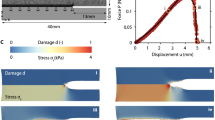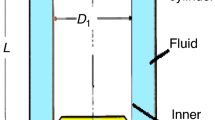Abstract
The phenomena of aggregation, breakdown, and disaggregation of the rouleaux of red blood cells (RBCs) in addition to deformability affect the human blood viscosity at different shear rates. In this study, the intermediate shear rate is introduced and defined when the effect of aggregation on the change of blood viscosity is diminished; and afterwards, the alteration in the blood viscosity is dominantly affected by the deformation of RBCs. With this respect, modeling the effective parameters on the blood shear-thinning behavior including hematocrit and plasma viscosity was performed for the two different shear regions discriminated by the proposed intermediate shear rates. The presented rheological model reflects a phenomenological approach to assess the human blood viscosity with an average error of ± 5% compared to experimental data for hematocrits between 0.299 and 0.702, subjected to various shear rates from 0.2 to 680 1/s. The temperature changes as well as biochemical effects on whole blood viscosity are characterized by the introduced plasma viscosity-dependent model. The presented comprehensive model could be used for better understanding of blood flow hemodynamics and analyzing the shear dependence of aggregation and deformability behaviors of RBCs.








Similar content being viewed by others
References
Popel AS, Johnson PC (2005) Microcirculation and hemorheology. Annu Rev Fluid Mech 37:43–69
Sequeira A (2018) Hemorheology: non-Newtonian constitutive models for blood flow simulations. Non-Newtonian fluid mechanics and complex flows. Springer, New York, pp 1–44
Tanveer A et al (2020) Theoretical analysis of non-Newtonian blood flow in a microchannel. Comput Methods Programs Biomed 191:105280
Bessonov N et al (2016) Methods of blood flow modelling. Math Model Nat Phenom 11(1):1–25
Yilmaz F, Gundogdu MY (2008) A critical review on blood flow in large arteries; relevance to blood rheology, viscosity models, and physiologic conditions. Korea-Aust Rheol J 20(4):197–211
Sousa PC et al (2016) A review of hemorheology: measuring techniques and recent advances. Korea-Aust Rheol J 28(1):1–22
Vitale F et al (2014) A multiscale, biophysical model of flow-induced red blood cell damage. AIChE J 60(4):1509–1516
Poorkhalil A et al (2016) A new approach for semiempirical modeling of mechanical blood trauma. Int J Artif Organs 39(4):171–177
Baskurt OK, Meiselman HJ (2003) Blood rheology and hemodynamics. In: Seminars in thrombosis and hemostasis. Copyright© 2003 by Thieme Medical Publishers, Inc., 333 Seventh Avenue, New …
Akar S, Esfahani JA, Shaegh SAM (2020) A numerical investigation on the magnetophoretic-guided stem cells delivery in a bend blood vessel. J Magn Magn Mater 498:166110
Kuhn V et al (2017) Red blood cell function and dysfunction: redox regulation, nitric oxide metabolism, anemia. Antioxid Redox Signal 26(13):718–742
Avsievich T et al (2020) The advancement of blood cell research by optical tweezers. Rev Phys 5:100043
Brooks D, Goodwin JW, Seaman GVF (1970) Interactions among erythrocytes under shear. J Appl Physiol 28:172–177
Achab L (2019) Numerical simulations of the pulsatile blood flow in narrowing small vessels using different rheological models. in Journal of Physics: Conference Series. IOP Publishing
Rogers S, Doctor A (2020) Red blood cell dysfunction in critical illness. Crit Care Clin 36(2):267–292
Robertson AM, Sequeira A, Kameneva MV (2008) Hemorheology. Hemodynamical flows. Springer, New York, pp 63–120
Ookawara S et al (2001) Estimate of red-cell deformability and plasma viscosity based on flow curve. AIChE J 47(1):230–239
Merril E et al (1963) Rheology of human blood, near and at zero flow. Biophys J 3:199–213
Piemjaiswang R et al (2021) Effect of temperature-dependent blood viscosity on low-density lipoprotein transport: numerical study. In: Journal of Physics: Conference Series. IOP Publishing
Sousa PC et al (2013) Shear viscosity and nonlinear behavior of whole blood under large amplitude oscillatory shear. Biorheology 50(5–6):269–282
Lowe G, Barbenel J (2019) Plasma and blood viscosity. Clin Blood Rheol. CRC Press, Boca Raton, pp 11–44
Campo-Deaño L, Oliveira MS, Pinho FT (2015) A review of computational hemodynamics in middle cerebral aneurysms and rheological models for blood flow. Appl Mech Rev 10(1115/1):4028946
Kannojiya V, Das AK, Das PK (2020) Simulation of blood as fluid: a review from rheological aspects. IEEE Rev Biomed Eng 14:327–341
Molla MM, Paul M (2012) LES of non-Newtonian physiological blood flow in a model of arterial stenosis. Med Eng Phys 34(8):1079–1087
Gujral K, Singh S (2020) Effect on flow characteristics of blood in overlapping stenosed artery considering the axial variation of viscosity using power-law non-Newtonian fluid model. Int J Comput Sci Math 11(4):397–409
Boyd J, Buick JM, Green S (2007) Analysis of the Casson and Carreau-Yasuda non-Newtonian blood models in steady and oscillatory flows using the lattice Boltzmann method. Phys Fluids 19(9):093103
Nazeer M et al (2021) Development of mathematical modeling of multi-phase flow of Casson rheological fluid: theoretical approach. Chaos, Solitons & Fractals 150:111198
Valencia A et al (2008) Blood flow dynamics in patient-specific cerebral aneurysm models: the relationship between wall shear stress and aneurysm area index. Med Eng Phys 30(3):329–340
Korolev KY, Verma AAK (2021) Analysis of Herschel-Bulkley model of blood flow through rough vessels. In Colloquium-journal. Голопристанський міськрайонний центр зайнятості
Amornsamankul S et al (2006) Effect of non-Newtonian behaviour of blood on pulsatile flows in stenotic arteries. Int J Biol Med Sci 1(1):42–46
Ahmad R et al (2021) An analytical approach to study the blood flow over a nonlinear tapering stenosed artery in flow of Carreau fluid model. Complexity. https://doi.org/10.1155/2021/9921642
Thondapu V et al (2018) Endothelial shear stress 5 years after implantation of a coronary bioresorbable scaffold. Eur Heart J 39(18):1602–1609
Hund SJ, Kameneva MV, Antaki JF (2017) A quasi-mechanistic mathematical representation for blood viscosity. Fluids 2(1):10
Apostolidis AJ, Beris AN (2014) Modeling of the blood rheology in steady-state shear flows. J Rheol 58(3):607–633
Moreno L et al (2015) Effect of cholesterol and triglycerides levels on the rheological behavior of human blood. Korea-Aust Rheol J 27(1):1–10
Wu Y-F et al (2018) Significantly increased low shear rate viscosity, blood elastic modulus, and RBC aggregation in adults following cardiac surgery. Sci Rep 8(1):1–10
Apostolidis AJ, Armstrong MJ, Beris AN (2015) Modeling of human blood rheology in transient shear flows. J Rheol 59(1):275–298
Armstrong M et al (2021) Importance of viscoelasticity in the thixotropic behavior of human blood. Rheol Acta 60(2):119–140
Horner JS et al (2019) Measurements of human blood viscoelasticity and thixotropy under steady and transient shear and constitutive modeling thereof. J Rheol 63(5):799–813
Ecker P et al (2021) Animal blood in translational research: how to adjust animal blood viscosity to the human standard. Physiol Rep 9(10):e14880
Ameenuddin M, Anand M, Massoudi M (2019) Effects of shear-dependent viscosity and hematocrit on blood flow. Appl Math Comput 356:299–311
Zydney A, Oliver J III, Colton C (1991) A constitutive equation for the viscosity of stored red cell suspensions: effect of hematocrit, shear rate, and suspending phase. J Rheol 35(8):1639–1680
Armstrong M et al (2018) Evaluating rheological models for human blood using steady state, transient, and oscillatory shear predictions. Rheol Acta 57(11):705–728
Armstrong M et al (2022) Tensorial formulations for improved thixotropic viscoelastic modeling of human blood. J Rheol 66(2):327–347
Rampling M (2019) Red cell aggregation and yield stress. Clin Blood Rheol. CRC Press, Boca Raton, pp 45–64
Fatahian E, Kordani N, Fatahian H (2018) A review on rheology of non-newtonian properties of blood. IIUM Eng J 19(1):237–250
Briley DP et al (1994) Spontaneous echo contrast and hemorheologic abnormalities in cerebrovascular disease. Stroke 25(8):1564–1569
Funding
The authors have not disclosed any funding.
Author information
Authors and Affiliations
Corresponding author
Ethics declarations
Conflict of interest
Hadi Tabesh, Ali Poorkhalil, Homa Akbari, Fojan Rafiei and Khosrow Mottaghy declares that they have no conflict of interest.
Ethical approval
This article does not contain any studies with human participants performed by any of the authors.
Additional information
Publisher’s Note
Springer Nature remains neutral with regard to jurisdictional claims in published maps and institutional affiliations.
Rights and permissions
Springer Nature or its licensor (e.g. a society or other partner) holds exclusive rights to this article under a publishing agreement with the author(s) or other rightsholder(s); author self-archiving of the accepted manuscript version of this article is solely governed by the terms of such publishing agreement and applicable law.
About this article
Cite this article
Tabesh, H., Poorkhalil, A., Akbari, H. et al. Phenomenological characterization of blood’s intermediate shear rate: a new concept for hemorheology. Phys Eng Sci Med 45, 1205–1217 (2022). https://doi.org/10.1007/s13246-022-01188-2
Received:
Accepted:
Published:
Issue Date:
DOI: https://doi.org/10.1007/s13246-022-01188-2




